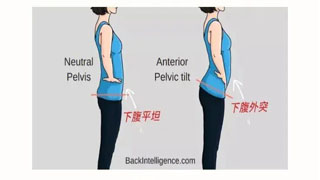
Do you have such distress——
Despite not being overweight or having a thick waist, one has a small belly and an upturned buttocks that are loose and flat
The upper abdomen is flat but the lower abdomen is protruding. Please be aware that you may have a pelvic tilt issue!
What is pelvic anterior tilt?
Anterior pelvic tilt refers to a pathological phenomenon caused by pelvic displacement. At the beginning, when the pelvic tilt angle is not significant, you may not have a noticeable sensation; But as the forward tilt angle becomes more and more severe, there may be a phenomenon of "false hip hump" with the buttocks protruding backwards as shown in the picture below.
There are many causes of pelvic tilt, such as——
▶ Long term desk work and prolonged sitting lead to shortening of the iliopsoas muscle.
▶ I like to cross my legs and pull my pelvis to offset.
▶ Frequently wearing high heels can cause the body's center of gravity to shift forward.
▶ Lack of exercise and weak abdominal muscles.
▶ During pregnancy, there is an increase in abdominal pressure, which can lead to pelvic tilt in order to maintain center of gravity balance.
What are the hazards of pelvic tilt forward?
▶ Constipation and dysmenorrhea
The pelvis supports the abdomen and protects internal organs. If pelvic tilt persists, it will affect the morphology and function of internal organs in the abdomen, leading to symptoms such as visceral prolapse, constipation, female dysmenorrhea, and menstrual discomfort.
▶ pain
Excessive anterior convexity of the lumbar spine disrupts the normal physiological curvature of the spine, which can lead to lower back and lower back pain over time, and even affect the shoulders and neck.
▶ chronic fatigue
Incorrect pelvic position may lead to long-term tension and stiffness of the iliopsoas and erector spinae muscles, which can easily cause chronic fatigue.
▶ Obesity in lower body segment
The change in body line of force causes the lower abdomen to protrude, the leg shape to deform, and the calf to become more prominent.
▶ Spinal degenerative changes
Imbalance of lumbar muscle strength can lead to increased spinal pressure, which can easily cause spinal degeneration and even intervertebral disc herniation.
How to self test pelvic tilt?
First, find a flat wall and stand against it, with the back of our head, shoulders, and heels on both sides pressed against the wall. Then insert a palm between our waist and the wall.
If the space between the waist and the wall is greater than the thickness of a palm, it is highly likely to be pelvic forward tilt. If the gap is greater than a fist, it is severe pelvic forward tilt.
Once pelvic tilt is detected, it must be taken seriously as soon as possible!
How to correct pelvic tilt?
Mild pelvic tilt can be corrected through self exercise or by seeking the help of a fitness coach with posture correction qualifications.
Below are some common training methods introduced
Everyone can exercise according to their own situation
▶ Arched stretching of iliopsoas muscle
Action essentials:
[Basic Version] Kneeling position, with the left knee forward and the right leg backward, the right hand lifted, the body bent to the left, and the right hip iliopsoas muscle felt stretched;
On the basis of the basic version, lift the right knee off the ground and push it backwards while the left knee moves forward, forming a front back pull.
Each group lasts for 20-30 seconds on each side, completing a total of 3 groups.
▶ Rolling like a ball, stretching the lower back
Action tips: Sit by the cushion, bow down, hook your feet and embrace your knees, inhale to make your body roll backwards like a ball, roll to the shoulder position, exhale, and then roll back to the starting position.
Each group completes 15 actions, for a total of 3 groups.
▶ Hip Bridge Training
Action tips: Keep both feet the same width as the pelvis, place both hands on both sides to stabilize the scapula, and use the hips to lift the legs at a 90 degree angle. Maintain a straight line between the rib arches and pubic bone.
Each action lasts 8-10 seconds, with 15 completed in each group, for a total of 3 groups.
▶ Dead bug training
Action essentials:
[Basic Version] Lie on a cushion with fingertips facing the ceiling, thighs perpendicular to the ground, hooked toes, legs greater than 90 degrees, inhale into the abdominal cavity, exhale to tighten the abdominal cavity, maintain a straight line between the rib arch and pubic bone, and then continue breathing training;
On the basis of dead worm breathing, exhale while extending the opposite hand and foot towards the distance, keeping the rib arch and pubic bone in a straight line, inhale and retract to the dead worm position, and alternate between practicing the opposite hand and foot.
Each group lasts from 30 seconds to 1 minute, completing a total of 3 groups.
▶ Daily posture adjustment
Adjusting daily posture is also essential for correcting pelvic tilt.
The correct sitting posture is to sit with both thigh bones facing backwards, with the two sitting legs upright on a stool and the body extended upwards.
The correct standing posture is to have both feet shoulder width apart, with the earlobe, acromion, greater trochanter of femur, lateral condyle of femur, and lateral condyle of tibia along the five point line.
So, quickly say goodbye to 'Ge You Lie Down' and put down your small phone and tablet, let's exercise together
Beautiful posture and body shape are waiting for you
Doctor's reminder:
If pelvic tilt is already very severe, it is recommended that you seek medical attention as soon as possible, receive professional assessment and rehabilitation training.


